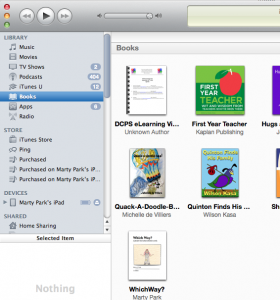Introduction to Which Way?
Project: Using iWork Pages to export to ePub format
Download and import this file into iTunes, then sync your iPad, iPhone, and/or iPod touch (unfortunately only using a USB cable – hopefully soon there will be some magic way to “air sync”). Update! you can now tap and air sync or pull in ePub files through Wifi. This is HUGE for schools.
- Download Which Way ePub (23 Mb – tap link): http://www.kyedtech.com/ePub/WhichWay.epub
- Download Properties of Parallelograms (12 Mb): http://www.kyedtech.com/ePub/Parallelograms.epub
- (upon request, I can also provide the .Pages files)
First, I authored this book (Which Way?) in 1999. It is a children’s picture book focusing on direction words. I decided to use it in this project to document the process of creating media rich content in ePub format for ‘offline consumption’ (meaning: providing ability to view while not connected to the Web). If a connection is always available, a simple web page or blog would be perfect.
Content Consumption vs. Content Creation: This is the hot topic right now. School leaders are currently studying this in detail. Can eReader or Pad/Tablet devices be considered for 1:1 projects? Well, my answer would be: Sure, but what is the instruction goal? The scenario playing out is that in many learning environments there is a need for “always on access to content”, and also leaders are pressing to use text book $ to purchase devices, citing that free content or teacher created custom content is available. … An iPad type device can help, it costs less than a laptop, and can be a tool for a student to do a lot in terms of teaching and learning. My pitch is that for parents to be comfortable with their kids NOT having a text book they have to see the value in the type of content accessed on the device (either online or offline). The environment, teachers, students, content creators and consumers alike to get a richer experience than a flat analog text book. That of course means: text, hyperlinks, video, audio, interactivity with embedded activities while in “the page.” Are you with me?
Why ePub? Simple, ePub affords an opportunity to have a true text and multimedia experience for the content consumers. Media rich, offline content, bring text and content alive with audio and video. Something PDF can not do. The next question, is how to distribute the content. For example, I want to get the ePub file to a bunch of students for them to view in the iBook App on their iPad. What is the best way to do that? We’ll be exploring that soon.
Why Pages? This pages template shows you how to use paragraph styles to create a publication that looks great and is easy to navigate in ePub readers like iBooks. Paragraph styles in Pages make it simple to create a unique look for each part of your publication — chapter names, topic headings, body text, and more. Keep in mind that text colors might look different in ePub format, and that on export, document text sizes will be translated into three sizes — small, medium, and large.
You can also use styles to indicate how you want your document to be organized when exported to ePub format. In Pages, the top-level paragraph style selected in the Document inspector’s TOC tab is used to create chapters in your publication. When your ePub file is opened in an ePub reader, any text based on a paragraph style used in the Pages Table of Contents is displayed in a special Table of Contents, with each entry linking to the corresponding content in your publication.
Getting Started with ePub
To use a standard document template as a starting point, simply download it, open in Pages, delete the instructions and add your own content to the next page:
- Link: http://support.apple.com/kb/HT4168
- Download the “ePub Best Practices” sample document at the following web address:
http://images.apple.com/support/pages/docs/ePub_Best_Practices_EN.zip
